Parque Natural de Urkiola · Ayuntamiento de Abadiño
Situación
Menú principal
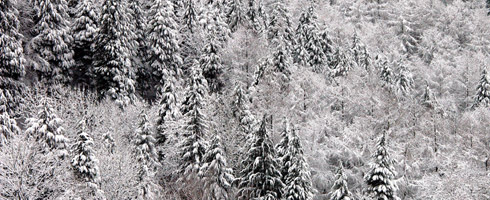
The exotic tree plantations cover large areas of the Urkiola Natural Park (23% of the surface area) and are fundamentally used to obtain word. Timber is the park‘s most important activity and the Monterry pine, European black pine, Scots Pine, Lawson Cypress and the Japanese Larch are the most common trees.
The Monterrey pine, originally from California, is planted in the valleys and on the slopes to 600-700 metres. This pine is the most widely used conifer and accounts for over half the plantations in the Park. However, at higher altitudes, trees such as cypresses and the larch are used as they withstand the cold and ice better. The Lawson cypresses, originally from the west of North America, is the second most common conifer in the Park. It has mainly been planted on the slopes of the Urkiolagirre and Saibi. That is followed by the European black pine, originally from Corsica and southern Italy, which has been widely used in the south of the Park, along with the Scots Pine. The Japanese larch is grown in small plantations between cypresses. Unlike the other conifers, it is deciduous and turns an attractive golden colour in autumn.
In addition to the above trees, other species have also been planted but the majority of times have not been so productive. The conifers include the red fir and the Douglas fir, and the deciduous trees include the American oak and the common plane.
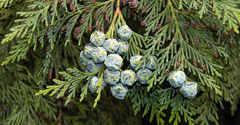
Perennial tree, up to 40 m high, narrow, dense and with a conical-pyramid crown. The trunk is straight and thick, particularly at the base. The bark is brown when young, but gets darker and cracks with age. The leaves are scale like and are arranged in four rows at the same level which makes the branches look adpressed. It blooms from March to May. The cones (fruits) are round, 7-10 mm in length and reddish-brown in colour. It is a native of the west coast of North America. There are extensive plantations on the mountains of the Urkiola National Park. It grows at over 600 m on the slopes of Mounts Urkiolagirre and Saibi. It is felled every 60-65 years and its wood is used for building and to make urban furniture, fencing, packaging and frames.
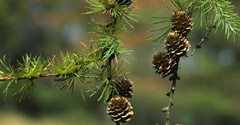
Deciduous tree up to 30 m high. Its truck is straight and cylindrical, with pendulous branches. The bark is greyish brown and rather cracked. The leaves are small needless and are grouped along the branches. Two lighter lines can be seen along the back of the leaf. It blooms from April to May. The female cones are yellow and produce small round pinecones. It is a native of Japan. There are few plantations of this tree in the Urkiola Natural Park. It can be found next to Toki Alai in the area surrounding the Urkiola Pass. The trees are felled every 60-65 years and their wood is used to make structures, flooring and posts.
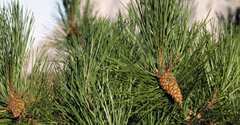
Perennial tree, up to 40 m high, with a conical-pyramid crown when young and more irregular when older. The bark is grey or brownish and rather cracked, but the young branches are very dark. The leaves are long (10-15 cm) and are hard needles that grow in pairs. It blooms from March to May. The pinecones grow by singly, in pairs or groups of three. It is a native of Corsica and the south of Italy. It has been widely planted in the Urkiola Natural Park, particularly on the southern slopes of Mounts Saibi and Urkiolagirre. It is felled every 60-65 years and its wood is used for building, fencing and packaging.
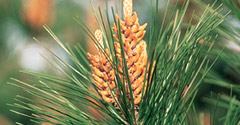
Perennial tree up to 30 m high. It is cone-shaped when young but the crown spreads as the tree ages. The trunk is straight and cylindrical and the dark brown bark is greatly cracked. The leaves are needles that are grouped in threes, that are rather long (7-15 cm) and flexible. It blooms from February to April. The yellow-brownish male cones form dense clusters and the pinecones are in groups of two to five. It is a native of California. It is the most widely-used tree in the Urkiola Natural Park plantations. It is felled roughly every 40 years and its wood is used for furniture, fencing, urban furniture, frames, packaging and paper.
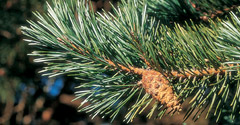
Perennial tree up to 40 m high. The crown is usually irregular in shape. Except in exposed areas, the trunk is straight and cylindrical and with few branches. The bark is scale-like and is reddish or pinkish in colour both at the base of the branches and the top part of the tree. The bluish-green leaves are short needles (3-7 cm). It blooms from May to June. The male cones are cylindrical and produce small pinecones, which are initially green but turn yellowish-brown when mature. The closest native pine forests are to be found in Orduña and in the Cuartango valley in Álava. It is felled every 60-65 years and its wood is used for building and to make furniture and posts.
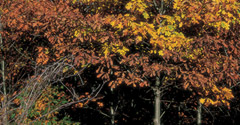
Deciduous tree, up to 30 m high and with a wide, round crown. The greyish-brown trunk is straight and cylindrical when young and rather cracked with age. It has large leaves, with clearly marked and sharp lobes. It blooms from May to June. The male catkins are long and the green female flowers appear in ones or twos. The fruit is a large acorn. It is a native of the east coast of North America. In Urkiola, it has been used in some Aldazitala reforestry projects and on the slope up from Mañaria to Urkiola. The leaves turn a spectacular orangey-red in autumn. Its wood is used to make furniture and packing.
2006 - 2007 © Anteiglesia de Abadiño Town Council - All rights reserved